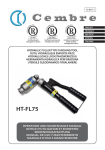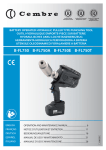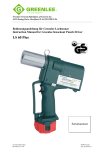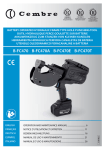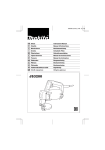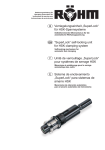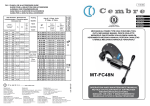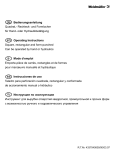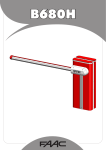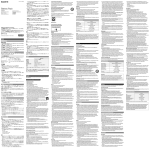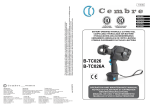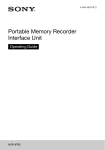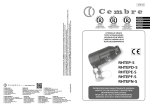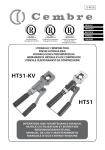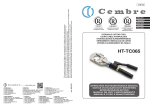Download Manuale d`uso e manutenzione
Transcript
15 M 104 ENGLISH FRANÇAIS DEUTSCH ESPAÑOL Certified Quality Management System Certified Environmental Management System Certified Occupational Health & Safety Management System HYDRAULIC PULLER TYPE PUNCHING HEAD TETE HYDRAULIQUE EMPORTE PIECE HYDRAULISCHER LOCHSTANZKOPF CABEZA HIDRÁULICA PERFORADORA TESTA OLEODINAMICA FORALAMIERE RH-FL75 OPERATION AND MAINTENANCE MANUAL NOTICE D'UTILISATION ET ENTRETIEN BEDIENUNGSANLEITUNG MANUAL DE USO Y MANTENIMIENTO MANUALE D'USO E MANUTENZIONE 1 ITALIANO TG 0350 WARNING LABELS - ETIQUETTES SIGNALETIQUES - WARNSCHILDER ETIQUETAS DE ATENCIÒN - ETICHETTE D'AVVERTENZA –Before using the tool, carefully read the instructions in this manual. –Avant d'utiliser cet outil, lire attentivement les instructions de cette notice. –Vor Inbetriebnahme unbedingt die Bedienungsanleitung durchlesen. –Antes de utilizar la herramienta, leer atentamente las instrucciones contenidas en este manual. –Prima di utilizzare l'utensile, leggere attentamente le istruzioni contenute in questo manuale. –When operating the tool, keep hands away from the danger zone. –Au cours de l'utilisation, tenir les mains éloignées de la zone de danger. –Während der Arbeit nicht mit den Händen in den Gefahrenbereich fassen. –Durante su utilización, mantenga las manos fuera de la zona de peligro. –Durante l'utilizzo, mantenere le mani fuori dalla zona di pericolo. –Always wear safety glasses and gloves when operating this tool. –Porter toujours les lunettes de protection et les gants de travail. –Immer mit Schutzbrille und Handschuhen bedienen. –Trabajar siempre con las gafas y guantes de seguridad. –Operare sempre con visiera protettiva e guanti da lavoro. TYPE FORCEFORCE MAX. PRESSURE 1 1 - Head type - Tête type - Typ Kopf - Cabeza tipo - Tipo di testa RH-FL75 75 kN 700 bar 10,000 psi Made in Italy 2 3 4 2 3 4 - Max. pressure - Max. pression - Max. Arbeitsdruck - Presión máxima - Pressione massima -Force -Force -Kraft -Fuerza -Forza -Year -Année -Jahr -Año -Anno 2 ENGLISH HYDRAULIC PULLER TYPE PUNCHING HEAD TYPE RH-FL75 CAUTION •Before each use, check the punches, dies and draw studs, and replace any that are worn or damaged, particulary any punches that have damaged cutting surfaces. • Damaged or improperly assembled accessories can break and hit the operator with sufficient force to cause serious injuries. •Before each use, verify the integrity of the head; replace any worn, possibly damaged or missing parts with original Cembre spares. • Only for use in punching holes in single layers of material and thicknesses as shown in TABLES 1 and 2. Any other use may cause components to break with potential risk of serious injury. •During operation do not allow anyone to pause in the work area, especially in front of the punch. • The use of Cembre punching accessories is recommended. Accessories from other suppliers may not be designed to withstand the force generated by this tool and may be damaged or break with potential risk of serious injury. 1. GENERAL CHARACTERISTICS – Application range: suitable for punching single layers of stainless steel, mild steel, fibreglass and plastic material. – Max. puncing capacity:............................................................................................ ø 140 mm (5.5 in.) – Developed force:........................................................................................................ 75 kN (8.4 sh.ton.) – Max. operating pressure:........................................................................................ 700 bar (10,000 psi) – Oil necessary (displacement):................................................................................ 25 cm3 (1.52 cu. in) –Dimensions:length.................................................................................................... 163 mm (6.41 in.) width..................................................................................................... 106 mm (4.17 in.) –Weight:............................................................................................................................ 1,9 kg (4.18 lbs) The part code “RH-FL75” includes the following: – Hydraulic head. – ø 11.5 mm Spiral bit (code 6134070). – TD-11 Draw stud with threaded 7/16"-3/4" (code 2685005). – TD-19 Draw stud with threaded 3/4"-3/4" (code 2685008). – Plastic carrying case type VAL P29. 2. INSTRUCTIONS FOR USE The head is supplied with an automatic, quick fit male coupler suitable for connection to a hydraulic, pneumatic or electrical 700 bar pump from the Cembre range. 3 ENGLISH 2.1)Setting – Connect the RH-FL75 head to a suitable pump (Ref. to Fig. 1); the head includes a rotating con nection which makes it easier to use in any position (Ref. to Fig. 2); – Consult the tables on pages 19 and 20 and select the RD... punching Kit suitable for the hole to be made. Round holes ø 15.5 to 30.5 mm (Ref. to Fig. 5) 1 – Drill a pilot hole in the plate at the desired point, using the ø 11.5 mm spiral bit supplied with the tool. 2–Fully screw the TD-11 draw stud into the ram (7) of the head. 3 – Thread the die onto the draw stud, pushing it to rest on the head. 4 – Insert the draw stud into the pilot hole and screw the punch onto the draw stud until its cutting edges are touching the back of the layer of material being punched. Round holes ø 28.5 to 80.5 mm (Ref. to Fig. 5) – Drill a pilot hole in the plate at the desired point, using a ø 20 mm spiral bit; alternatively, it is possible to make the pilot hole with the ø 11.5 mm spiral bit supplied with the tool and widen it with the KIT RD20.5SS. – Fully screw the draw stud TD-19 into the ram (7) of the head. NOTE: the TD-19 draw stud is threaded 3/4" at both ends, screw the short thread into the ram. – Continue as described in points 3 and 4 above. Round holes ø 100 and 120 mm (Ref. to Fig. 5) – Drill a pilot hole in the plate at the desired point, using a ø 29 mm spiral bit; alternatively, it is possible to make the pilot hole with the ø 11.5 mm spiral bit supplied with the tool and widen it with the KIT RD30.5SS. – Fully screw the draw stud TD-28,5 (supplied with the Punching Kit) into the ram (7) of the head. – Continue as described in points 3 and 4 above. Square and rectangular holes (Ref. to Fig. 5) – With a drill make the required pilot hole in the plate (see Tab. 2) at the desired point. – Fully screw the draw stud (supplied with the Punching Kit) into ram (7) of the head. – Thread the die into the draw stud, pushing it to rest on the head. – Insert the draw stud into the pilot hole then thread the punch onto the draw stud until its cutting edges are touching the back of the layer of material being punched. – Fully screw the locking ring onto the draw stud to lock the punch in place. 2.2) Punching (Ref. to Figs. 3 and 4) Before punching: • • • • Check the correct match between die and punch. Check that the draw stud is completely screwed into the ram. Check that the punch is completely screwed onto the stud, with its cutting edges touching the back of the layer of material being punched. Keep hands away from the punching zone to avoid serious risk of injury! – Operate the pump to advance the ram and punch to achieve the required hole. 4 ENGLISH 2.3) Retracting the punch – Release the oil pressure from the pump and fully retract the ram. – Remove the punch from the draw stud then carefully and completely remove punch scrap and any residue from the die. 3. MAINTENANCE The oil pressure inside the head must always be completely released before disconnecting the head from the hose. All maintenance operations must be performed with the head disconnected from the hydraulic pump hose. The hydraulic head is robust and requires very little daily maintenance. Compliance with the following points should help to maintain the optimum performance of the tool: 3.1) Accurate cleaning Dust, sand and dirt are a danger for any hydraulic device. Avoid putting the head on muddy or dusty ground. Any dirt particles may score the ram and create oil leaks. Every day, after use, the head must be wiped with a clean cloth, taking care to remove any residual particles, especially around the moving parts. 3.2) Replacement of the automatic coupler To replace the automatic coupler proceed as follows: – Remove the old coupler. – Carefully clean the thread of the nipple to remove the old sealant. – Apply teflon tape to the thread. – Fit the new automatic coupler and tighten to 30 Nm (22 lbf ft). 3.3) Storage (Ref. to Fig. 7) When not in use, the head should be stored and transported in the plastic case, to prevent damage. Plastic case: VAL P29: size 448x288x105 mm (17.6x11.3x4.1 in.); weight 1.4 kg (3.1 lbs) This case is suitable to contain the head and punching accessories. FIG. 7 4.USE OF NON ORIGINAL Cembre PUNCHING ACCESSORIES To obtain the best operating results, the use of original Cembre punching accessories is recommended; as an alternative, it is possible to use punching accessories made by other manufacturers by requesting separately the specific adaptor (see Table 3). Check the compatibility of the accessories with the characteristics of the RH-FL75 head. 5. RETURN TO Cembre FOR OVERHAUL In the case of a breakdown contact our Area Agent who will advise on the problem and provide the necessary instructions on how to dispatch the tool to our next service Centre; if possible, attach a copy of the Test Certificate supplied by Cembre together with the tool or, if no other references are available, indicate the approximate purchase date and the tool serial number. 5 FRANÇAIS TETE HYDRAULIQUE EMPORTE PIECE TYPE RH-FL75 ATTENTION • Avant chaque utilisation, contrôler les poinçons, les matrices et les tirants et les remplacer en cas d'usure ou dommage, remplacer les poinçons qui présenteraient des surfaces de coupe endommagées. • Des accessoires endommagés ou mal montés peuvent se rompre et atteindre l’opérateur avec une force suffisante pour provoquer des lésions graves. • Avant chaque utilisation, vérifier que la tête est en bon état; remplacer les pièces usagées et éventuellement endommagées ou manquantes avec des pièces de rechange originales Cembre. • Ne pas faire de trous à travers deux couches ou plus de matériau; ceci pourrait provoquer la rupture du tirant ou du poinçon. • Durant le perçage ne permettre à personne de rester dans la zone de travail, surtout devant le poinçon. •Il est conseillé d’utiliser des accessoires de perçage Cembre. Les accessoires de perçage d’autres fabricants pourraient s’abîmer ou ne pas résister à la force générée par cet outil ce qui aurait des conséquences également graves pour la sécurité des personnes. 1. CARACTERISTIQUES GENERALES – Domaine d'application: conçue pour percer des tôles d’acier inoxydable, l’acier doux, des parois en fibre de verre et la matière plastique. – Capacité de perforation max.:................................................................................ø 140 mm (5.5 in.) – Force développée:.......................................................................................................75 kN (8.4 sh.ton.) – Pression max.:...............................................................................................................700 bar (10,000 psi) – Huile nécessaire (déplacement):............................................................................25 cm3 (1.52 cu. in) –Dimensions:hauteur................................................................................................. 163 mm (6.41 in.) largeur.................................................................................................. 106 mm (4.17 in.) –Poids:............................................................................................................................... 1,9 kg (4.18 lbs) La référence “RH-FL75” désigne l'ensemble suivant: – Tête hydraulique. – Foret hélicoïdal ø11.5 mm (cod. 6134070). – Tirant “TD-11” fileté 7/16"-3/4" (cod. 2685005). – Tirant “TD-19” fileté 3/4"-3/4" (cod. 2685008). – Coffret de rangement en plastique type VAL P29. 2. INSTRUCTIONS D'UTILISATION La tête est munie d’un raccord rapide mâle à blocage automatique et peut être reliée aussi bien à des pompes hydrauliques à pied, qu’à des pompes pneumo et électro-hydrauliques Cembre à 700 bar. 6 FRANÇAIS 2.1)Mise en service – Raccorder la tête RH-FL75 à la pompe hydraulique (Réf. Fig. 1). La tête est dotée d'un raccord tournant qui en facilite l’utilisation quelle que soit la position (Réf. Fig. 2). – En consultant le tableau de la page 19 et 20, choisir le KIT de perforation RD... adapté au trou à effectuer. Trous ronds de ø 15,5 mm à 30,5 mm (Réf. a Fig. 5) 1 – A l’aide d’une perceuse, faire un avant-trou dans la tôle à l’endroit établi en utilisant le foret hélicoïdal ø 11.5 mm fourni avec l'outil. 2–Visser complètement le tirant TD-11 dans le piston (7) de la tête. 3 – Enfiler la matrice dans le tirant en la poussant pour qu’elle s’appuie sur la tête. 4 – Insérer le tirant dans le trou déjà percé et visser le poinçon sur le tirant jusqu’à la tôle. Trous ronds de ø 28,5 à 80,5 mm (Réf. a Fig. 5) – A l’aide d’une perceuse, faire un avant-trou dans la tôle à l’endroit établi en utilisant un foret hélicoïdal ø 20 mm; comme alternative il est possible de faire le avant-trou avec le foret hélicoïdal ø 11.5 mm fourni avec l'outil et l’élargir avec le KIT RD20.5SS. –Visser complètement le tirant TD-19 dans le piston (7) de la tête. NOTES: le tirant TD-19 est fileté 3/4” aux deux extrémités; visser dans le piston le côté avec le filetage le plus court. – Continuer comme décrit aux points précédents 3 et 4. Trous ronds de ø 100 et 120 mm (Réf. a Fig. 5) – A l’aide d’une perceuse, faire un avant-trou dans la tôle à l’endroit établi en utilisant un foret hélicoïdal ø 29 mm; comme alternative il est possible de faire le avant-trou avec le foret hélicoïdal ø 11.5 mm fourni avec l'outil et l’élargir avec le KIT RD30.5SS. –Visser complètement le tirant TD-28,5 (fourni avec le kit de perçage) dans le piston (7) de la tête. – Continuer comme décrit aux points précédents 3 et 4. Trous carrés et rectangulaires (Réf. a Fig. 5) – A l’aide d’une perceuse, faire un avant-trou dans la tôle (Réf. Tab.2) à l’endroit établi. –Visser complètement le tirant (fourni avec le kit de perçage) dans le piston (7). – Enfiler la matrice dans le tirant en la poussant pour qu’elle s’appuie sur la tête. – Insérer le tirant dans le trou puis insérer le poinçon sur le tirant jusqu’à ce qu’il bute contre la tôle. –Visser complètement la vis de blocage sur le tirant pour bloquer l’ensemble. 2.2)Perçage (Réf. a Fig. 3 et 4) Avant d’effectuer le perçage: • • • • Vérifier que le couplage entre la matrice et le poinçon correspondant est correct. Vérifier que le tirant est complètement vissé dans le piston de la tête. Vérifier que le poinçon est complètement vissé sur le tirant jusqu’à ce qu’il bute contre la tôle. Tenir les mains éloignées de la zone de perçage. Risque de lésions! – Actionner la pompe hydraulique: le mouvement du piston commencera entraînant ainsi le dé placement en avant du poinçon et le perçage de la tôle. 7 FRANÇAIS 2.3) Réouverture del poinçon (Réf. a Fig. 4) – Pour rouvrir l'ensemble, agir sur le dispositif d’évacuation de la pression d’huile de la pompe jusqu’à ce que le piston et le poinçon soit complètement rétractée. – Démonter le poinçon du tirant et expulser le copeau de perçage de la matrice; vérifier qu’il ne reste aucun résidu de découpage à l’intérieur de la matrice. 3. ENTRETIEN Avant de débrancher le raccord rapide qui relie la tête au flexible de la pompe hydraulique, vérifier que la pression de l’huile a été complètement évacuée. Toutes les opérations d’entretien doivent être effectuées sur la tête débranchée du flexible de la pompe hydraulique. Cette tête est robuste et ne nécessite aucune préoccupation ou entretien particulier. Les recommandations qui suivent sont néanmoins souhaitables pour lui assurer une longévité optimum: 3.1) Nettoyage élémentaire Veiller à protéger l'outil de la poussiére, du sable et de la boue qui sont un danger à tout système hydraulique. Chaque jour après utilisation, l'outil doit être nettoyé à l'aide d'un chiffon propre, tout particulièrement aux endroits de pièces mobiles. 3.2) Remplacement du raccord rapide Pour remplacer le raccord rapide, procéder de la façon suivante: – Dévisser l'ancien raccord rapide de la tête. – Nettoyer soigneusement le filetage du cylindre pour enlever tous les résidus de téflon. – Recouvrir le filetage du cylindre de téflon. – Visser le raccord rapide neuf sur la tête en appliquant un couple de serrage de 30 Nm (22 lbf ft). 3.3) Rangement (Réf. a Fig. 7) Il est de bonne règle de remettre l'outil dans son coffret, fermé, après usage, en protection des chocs et de la poussière. Le coffret (type VAL P29) a comme dimensions 448x288x105 mm (17.6x11.3x4.1 in.) et un poids de 1.4 kg (3.1 lbs) est adapté pour contenir l'outil et les accessoires pour la perforation. FIG. 7 4. UTILISATION DES ACCESSOIRES DE PERÇAGE NON ORIGINAUX Cembre Pour obtenir les meilleurs résultats opérationnels, il est conseillé d'utiliser des accessoires de perçage originaux Cembre, sinon il est possible d'utiliser des accessoires de perçage d'autres fabricants qui exigent leurs propres kits d’adaptation spécifiques (Réf. Tableau 3). Vérifier la compatibilité des accessoires avec les caractéristiques de la tête RH-FL75. 5.ENVOI EN REVISION A Cembre En cas de dysfonctionnement de l'appareil, merci de vous adresser à notre Agent Régional qui vous conseillera et le cas échéant vous donnera les instructions nécessaires pour envoyer l'outil à notre Centre de Service le plus proche. Dans ce cas, joindre une copie du Certificat d'Essai livré par Cembre avec l'outil ou, à défaut d'autres éléments de référence, indiquer la date d'achat approximative et numéro de série. 8 DEUTSCH HYDRAULISCHER LOCHSTANZKOPF TYP RH-FL75 ACHTUNG • Vor jeglicher Benutzung die Stempel, Matrizen, und Zugbolzen überprüfen und bei Verschleiß oder Beschädigung ersetzen. Stempel mit beschädigten Schnittkanten ersetzen. •Beschädigte oder falsch zusammengebaute Werkzeuge können Brechen und Personen mit einer dermaßen großen Kraft treffen, dass diese schwere Verletzungen davontragen können. •Vor jeder Benutzung die Unversehrtheit des Kopfes überprüfen. Verschlissene, beschädigte oder fehlende Teile durch Originalersatzteile von Cembre ersetzen. • Es dürfen keine Stanzungen mit zwei oder mehreren Materialschichten und höheren Materi alstärken als in TABELLE 1 und 2 angegeben ist, durchgeführt werden. Das könnte zur Beschädigung des Zugbolzens oder des Stempels führen und es besteht eine große Gefahr für das Personal. • Während der Stanzung niemandem erlauben, im Arbeitsbereich zu verweilen – vor allem darf sich niemand vor dem Stempel aufhalten. • Es wird die Verwendung des Stanzzubehörs von Cembre empfohlen. Stanzzubehör anderer Hersteller könnte sich beschädigen oder der von diesem Werkzeug erzeugten Kraft nicht standhalten. Daraus leitet sich eine große Gefahr für die Unversehrtheit des Personals ab. 1. ALLGEMEINE EIGENSCHAFTEN –Anwendungsbereich: geeignet zum Stanzen von rostfreiem Stahlblech, Weichstahl, Material aus Glasfaser- und Kunststoffmaterial. – Max. Stanzleistung.................................................................................................... ø 140 mm (5.5 in.) –Kraft:................................................................................................................................ 75 kN (8.4 sh.ton.) – Max. Arbeitsdruck:..................................................................................................... 700 bar (10,000 psi) (1.52 cu. in) – Erforderliche Öl (Hubraum):................................................................................... 25 cm3 –Abmasse:Länge.......................................................................................................... 163 mm (6.41 in.) Breite........................................................................................................... 106 mm (4.17 in.) –Gewicht:......................................................................................................................... 1,9 kg (4.18 lbs) Unter der Bezeichnung “RH-FL75” werden folgende Teile geliefert: – Hydraulischer Kopf. – Spiralbohrer ø11.5 mm (Art.Nr. 6134070). – Zugbolzen “TD-11” mit ein Gewinde 7/16"-3/4" (Art.Nr. 2685005). – Zugbolzen “TD-19” mit ein Gewinde 3/4"-3/4" (Art.Nr. 2685008). – Kunststoffkoffer VAL P29. 2. BEDIENUNGSHINWEISE Der Kopf ist mit einer ölverlustfreien Schnellkupplung versehen und kann sowohl mit 700 bar hydraulischen Pumpen mit Pedal als auch mit pneumatisch-sowie elektrohydraulischen Pumpen der Firma Cembre verbunden werden. 9 DEUTSCH 2.1)Vorbereitung – Den Kopf RH-FL75 an die ölhydraulische Pumpe anschließen (siehe Bild. 1). Der Kopf besteht hat einen drehbaren Anschluss, der eine Verwendung in jeder Position ermög licht (siehe Bild. 2). – Aus den Tabellen auf den Seite 19 und 20 das entsprechende KIT RD... auswählen. Rundstanzungen von ø 15,5 bis 30,5 mm (siehe Bild 5) 1 – Zur Führung mit einer Bohrmaschine am festgelegten Punkt eine Pilotbohrung in das Blech bohren. Die Pilotbohrung mit dem Spiralbohrer der Größe ø11.5 mm ausführen, der zum Lieferumfang gehört. 2 – Den Zugbolzen TD-11 vollständig in den Kolben (7) des Kopfes eindrehen. 3 – Die Matrize auf den Zugbolzen aufsetzen und sie bis zum Anschlag an den Kopf schieben. 4 – Den Zugbolzen in die Pilotbohrung einführen und den Stempel auf den Zugbolzen bis zum Blech aufschrauben. Rundstanzungen von ø 28,5 bis 80,5 mm (siehe Bild 5) – Zur Führung mit einer Bohrmaschine am festgelegten Punkt eine Pilotbohrung in das Blech bohren. Dabei einen Spiralbohrer ø 20 mm benutzen. Alternativ dazu kann die Pilotbohrung mit dem Bohrer der Größe ø 11.5 mm Anschließend die Bohrung mit dem KIT RD20,5SS erweitern. – Den Zugbolzen TD-19 vollständig in den Kolben (7) des Kopfes eindrehen. Anmerkung: Der Zugbolzen TD-19 hat an beiden Enden ein 3/4"-Gewinde. In den Kolben die Seite mit dem kürzeren Gewinde eindrehen. – Gemäß den vorher beschriebenen Punkten 3 und 4 fortfahren. Rundstanzungen von ø 100 und 120 mm (siehe Bild 5) – Zur Führung mit einer Bohrmaschine am festgelegten Punkt eine Pilotbohrung in das Blech bohren. Dabei einen Spiralbohrer ø 29 mm benutzen. Alternativ dazu kann die Pilotbohrung mit dem Bohrer der Größe ø 11.5 mm Anschließend die Bohrung mit dem KIT RD30,5SS erweitern. – Den Zugbolzen TD-28,5 (er ist im Lieferumfang des KIT RD.. enthalten) vollständig in den Kolben (7) des Kopfes eindrehen. – Gemäß den vorher beschriebenen Punkten 3 und 4 fortfahren. Quadratische und rechteckige Stanzungen (siehe Bild 5) – Zur Führung am festgelegten Punkt mit einer Bohrmaschine eine Pilotbohrung in das Blech (siehe Tabelle 2) bohren. – Den Zugbolzen vollständig in den Kolben (7) einschrauben (er ist im Lieferumfang des KIT RD.. enthalten). – Die Matrize auf den Zugbolzen aufsetzen und sie bis zum Anschlag an den Kopf schieben. – Den Zugbolzen in die Pilotbohrung einsetzen und den Stempel auf dem Zugbolzen bis zum Blech schieben. – Die Kontermutter vollständig auf den Zugbolzen aufschrauben, um alle Bauteile zu fixieren. 2.2)Stanzung (siehe Bild 3 und 4) Vor dem Stanzen folgendes beachten: • • • • Den ordnungsgemäßen Anschluss der Matrize am entsprechenden Stempel kontrollieren. Die vollständige Verschraubung des Zugbolzens im Kolben des Kopfes überprüfen. Die vollständige Verschraubung des Stempels auf dem Zugbolzen (bis zum Blech) überprüfen. Nicht in den Stanzbereich fassen. Verletzungsgefahr! – Die Pumpe, mit der der Kopf verbunden ist, betätigen: der Kolben beginnt sich zu bewegen, der Stempel wird dadurch vorangetrieben und es erfolgt das Stanzen des Bleches. 10 DEUTSCH 2.3) Erneutes Öffnen des Stempels (siehe Bild. 4) – Um die Stanzvorrichtung erneut zu öffnen, die Vorrichtung zum Ablassen des Pumpen drucks solange aktivieren, bis sich der Kolben (07) vollständig zurückgezogen hat. – Den Stempel vom Zugbolzen abmontieren und den Stanzabfall aus der Matrize entfernen. Über prüfen, dass keine Stanzrückstände innerhalb der Matrize zurückbleiben. 3. WARTUNG Vor dem Verbinden des Kopfes mit dem Schnellanschluss mit dem Hochdruckschlauch der hydraulischen Pumpe hat man sich zu vergewissern, daß der Öldruck vollständig abgelassen worden ist. Für sämtliche Arbeiten am Stanzkopf muss der Stanzkopf vom Schlauch abgekuppelt sein. Der Kopf ist robust und benötigt keine spezielle Pflege oder Instandhaltung. Zur Erhaltung der Garantieansprüche beachten Sie folgende Hinweise: 3.1) Pflege Dieses hydraulische Werkzeug sollte vor starker Verschmutzung geschützt werden, da diese für ein hydraulisches System gefährlich ist. Jeden Tag nach der Arbeit sollte das Werkzeug mit einem Tuch von Schmutz und Staub gereinigt werden, besonders die beweglichen Teile. 3.2) Ersatz des Schnellanschlusses Wie folgt vorgehen, um den Schnellanschluß zu ersetzen: – Den alten Schnellanschluß des Kopfes losschrauben. – Das Außengewinde des Zylinders sorgfältig reinigen und die Rückstände der alten Dichtung entfernen. – Ein Teflon-Band um das Außengewinde wickeln, um die Dichtung erneut herzustellen. – Den neuen Schnellanschluß mit einem Drehmoment von 30 Nm auf dem Kopf ein schrauben. 3.3) Lagerung (siehe Bild 7) Wenn das Werkzeug nicht benötigt wird, sollte es in der Kunststoffkassette gelagert werden und ist somit gegen Beschädigungen wie Stoss und Staub geschützt. Die Kunststoffkassette (Typ VAL P29) hat die Abmasse 448x288x105 mm (17.6x11.3x4.1 in.) und ein Gewicht von 1.4 kg (3.1 lbs). Geeignet zum Lagern das Werkzeug und Zubehör. BILD 7 4. EINSATZ VON STANZWERKZEUGEN VON FREMDLIEFERANTEN Um beste Ergebnisse zu erzielen, sollte das Originalstanzzubehör von Cembre benutzt werden. Alternativ dazu kann Stanzzubehör anderer Hersteller mit einem speziellen separat zu bestellenden Adapter verwendet werden (siehe Tabelle 3). Die Kompatibilität der Werkzeuge anhand der Kennwerte des Kopfes RH-FL75 prüfen. 5. EINSCHICKEN AN Cembre ZUR ÜBERPRÜFUNG Sollten am Gerät Fehler auftauchen, wenden Sie sich bitte an unsere Gebietsvertretung, welche Sie gerne beraten und Ihnen alle nötigen Informationen zum Einschicken des Gerätes an unseren Hauptsitz geben wird. Wenn vorhanden, legen Sie dem Gerät bitte das von Cembre mitgelieferte Überprüfungszertifikat bei; In Ermangelung dieser Informationen geben Sie bitte an, wann Sie das Gerät erworben haben. 11 ESPAÑOL CABEZA HIDRÁULICA PERFORADORA TIPO RH-FL75 ADVERTENCIAS •Antes de cada uso, revisar los punzones, las matrices y los tirantes y sustituirlos en caso de desgaste o daños. Sustituir los punzones que presenten superficies de corte dañadas. •Los accesorios dañados o montados de forma inadecuada pueden romperse y golpear al operario con una fuerza suficiente para causar lesiones graves. •Antes de cada uso, comprobar la integridad de la cabeza. Sustituir las partes desgastadas, dañadas o ausentes con piezas de recambio originales Cembre. • No realizar orificios a través de dos o más capas de material o con espesores superiores a los que se muestran en las TABLAS 1 y 2. Esto podría causar la rotura del tirante o del punzón y causar lesiones graves. •Durante la perforación, no permitir a nadie permanecer en la zona de trabajo, sobre todo delante del punzón. •Se recomienda el uso de accesorios de perforación Cembre. Los accesorios de perforación de otros fabricantes podrían dañarse o no resistir a la fuerza generada por este utensilio con consecuencias que pueden ser incluso graves en la integridad personal. 1. CARACTERISTICAS GENERALES – Campo de aplicación: idónea para perforar chapa de acero inoxidable, acero dulce, paredes de fibra de vidrio y material plástico. – Capacidad máxima de perforación:................................................................... ø 140 mm (5.5 in.) – Fuerza desarrollada:.................................................................................................. 75 kN (8.4 sh.ton.) – Presión máxima de trabajo:................................................................................... 700 bar (10,000 psi) (1.52 cu. in) – Aceite necesario (desplazamiento):..................................................................... 25 cm3 –Dimensiones: longitud............................................................................................. 163 mm (6.41 in.) anchura.............................................................................................. 106 mm (4.17 in.) –Peso:................................................................................................................................. 1,9 kg (4.18 lbs) Con la referencia “RH-FL75” se identifica el conjunto formado por: – Cabeza hidráulica. – Broca helicoidal ø11.5 mm (cod.6134070). – Tirante “TD-11” con rosca 7/16"-3/4" (cod. 2685005). – Tirante “TD-19” con rosca 3/4"-3/4" (cod. 2685008). – Cofre de almacenamiento tipo VAL P29. 2. INSTRUCCIONES DE USO La cabeza está provista de un acoplamiento rápido automático, y puede ser conectada tanto a bombas hidráulicas de pedal, como a bombas neumo y electro-hidráulicas de 700 bar fabricadas por Cembre. 12 ESPAÑOL 2.1)Preparación – Conectar la cabeza RH-FL75 con la bomba oleodinámica (Ref. en Fig. 1). La cabeza está dotada de un empalme giratorio que facilita su uso en cualquier posición (Ref. en Fig. 2). – Consultando las tablas de la pág. 19 y 20, elegir el kit de perforación RD... adecuado para el orificio que se debe realizar. Orificios redondos de ø 15,5 a 30,5 mm (Ref. en Fig 5) 1–Con un taladro, realizar un pre-orificio piloto en la chapa en el punto establecido utilizando la broca helicoidal de ø1 1,4 mm en dotación con la cabeza. 2–Enroscar completamente el tirante TD-11 en el pistón (7) de la cabeza. 3 – Introducir la matriz en el tirante empujándola contra la cabeza. 4 – Introducir el tirante en el pre-orificio y enroscar completamente el punzón en el tirante hasta la chapa. Orificios redondos de ø 28,5 a 80,5 mm (Ref. en Fig 5) – Con un taladro, realizar un pre-orificio piloto en la chapa en el punto establecido utilizando una broca helicoidal de ø 20 mm. Como alternativa, se puede realizar el pre-orificio con la broca de ø 11.5 mm y ensancharlo con el KIT RD20.5SS. – Enroscar completamente el tirante TD-19 en el pistón (7) de la cabeza. Nota: el tirante TD-19 está roscado 3/4" en ambos extremos. Enroscar en el pistón por el lado con la rosca más corta. – Continuar como se describe en los puntos 3 y 4 anteriores. Orificios redondos de ø 100 y 120 mm (Ref. en Fig 5) – Con un taladro, realizar un pre-orificio piloto en la chapa en el punto establecido utilizando una broca helicoidal de ø 29 mm. Como alternativa, se puede realizar el pre-orificio con la broca de ø 11.5 mm en dotación y ensancharlo con el KIT RD30.5SS. – Enroscar completamente el tirante TD-28,5 (proporcionado en dotación con el kit de perforación) en el pistón (7) de la cabeza. – Continuar como se describe en los puntos 3 y 4 anteriores. Orificios cuadrados y rectangulares (Ref. en Fig 5) – Con un taladro, realizar un pre-orificio piloto en la chapa (Ref. en Tab. 2) en el punto establecido. –Enroscar completamente el tirante (proporcionado con el kit de perforación) en el pistón (7). – Introducir la matriz en el tirante empujándola contra la cabeza. – Introducir el tirante en el pre-orificio y después introducir el punzón en el tirante hasta llegar a la chapa. –Enroscar completamente la contera de bloqueo en el tirante para bloquear todo. 2.2)Perforación (Ref. en Fig. 3 y 4) Antes de proceder a la perforación: • • • • Comprobar el acoplamiento correcto entre la matriz y el punzón correspondiente Comprobar que se enrosque completamente el tirante en el pistón de la cabeza. Comprobar que se enrosque completamente el punzón en el tirante hasta llegar a la chapa. Mantener las manos lejos de la zona de perforación. ¡Peligro de lesiones! – Accionar la bomba oleodinámica: empezará el movimiento del pistón con el consiguiente avance del punzón y la posterior perforación de la chapa. 13 ESPAÑOL 2.3) Reapertura del punzón – Para volver a abrir el conjunto, actuar sobre el dispositivo de evacuación de la presión de la bomba hasta que el pistón (07) esté retraído completamente. – Desmontar el punzón por el tirante y expulsar las virutas de perforación de la matriz. Comprobar que no queden residuos de perforación dentro de la matriz (Ref. en Fig. 4). 3. MANTENIMIENTO Antes de desensamblar el acoplamiento rápido que une la cabeza a la manguera de la bomba hidráulica, comprobar que se ha evacuado completamente la presión del aceite. Todas las operaciones de mantenimiento se deben llevar a cabo con la cabeza desconectada de la manguera de la bomba hidráulica. Esta cabeza es robusta y no requiere cuidados especiales para obtener un funcionamiento correcto, bastará tener algunas precauciones sencillas: 3.1) Limpieza adecuada Tenga presente que el polvo, la arena y la suciedad en general, representan un peligro para toda herramienta hidráulica. Tras cada día de uso, se debe limpiar la herramienta con un trapo limpio, teniendo cuidado de eliminar la suciedad depositada, especialmente junto a las partes móviles. 3.2) Cambio del acoplamiento rápido Para cambiar el acoplamiento rápido, actuar de la manera siguiente: – Desenroscar el acoplamiento rápido usado de la cabeza. – Limpiar cuidadosamente la rosca macho del cilindro para quitar todo residuo de la junta antigua. – Reconstituir la junta en la rosca macho del cilindro con cinta de teflón. – Enroscar el acoplamiento rápido nuevo sobre la cabeza apretando con un par 30 Nm (22 lbf ft). 3.3) Almacenamiento (Ref. a Fig. 7) Para proteger la cabeza de golpes accidentales y del polvo cuando no se va a utilizar, es conveniente guardarla en su estuche de plástico de cierre hermético. Dicho estuche (mod. VAL P29) de dimensiones 448x288x105 mm (17.6x11.3x4.1 in.) y pesa 1.4 kg (3.1 lbs), es apropriado para almacenar la herramienta y los accesorios de perforación. FIG. 7 4. USO DE ACCESORIOS DE PERFORACIÓN NO ORIGINALES Cembre Para obtener los mejores resultados operativos, se recomienda el uso de accesorios de perforación originales Cembre. Como alternativa, se pueden utilizar accesorios de perforación de otros fabricantes pidiendo por separado los kits de adaptación específicos (Ref. en Tabla 3). Comprobar la compatibilidad de los accesorios con las características de la cabeza RH-FL75. 5. DEVOLUCION A Cembre PARA REVISIONES En caso de fallo de la cabeza, contactar con nuestro Agente de Zona quien les aconsejará y eventualmente les facilitará las instrucciones necesarias para remitir la herramienta a nuestro centro de servicio más cercano. En tal caso, adjuntar ser posible una copia del Certificado de Ensayo entregado en su día por Cembre con la herramienta o a falta de otro elemento de referencia indicar la fecha de compra aproximada y el número de serie. 14 ITALIANO TESTA OLEODINAMICA FORALAMIERE TIPO RH-FL75 AVVERTENZE • Prima di ogni utilizzo controllare punzoni, matrici e tiranti e sostituirli in caso di usura o dan neggiamento, sostituire i punzoni che presentassero taglienti danneggiati. • Accessori danneggiati o impropriamente assemblati possono rompersi e colpire l'operatore con una forza sufficiente a causare lesioni gravi. • Prima di ogni utilizzo verificare l'integrità della testa; sostituire le parti usurate, eventualmente danneggiate o mancanti con parti di ricambio originali Cembre. • Non effettuare fori attraverso due o più strati di materiale o su spessori superiori a quelli indicati nelle TABELLE 1 e 2; ciò potrebbe causare la rottura del tirante o del punzone con conseguenze anche gravi sull’incolumita’ personale. • Durante la foratura non permettere a nessuno di sostare nell'area di lavoro, soprattutto davanti al punzone. • E consigliato l'utilizzo di accessori di foratura Cembre. Accessori di foratura di altri produttori potrebbero danneggiarsi o non resistere alla forza generata da questo utensile con conseguenze anche gravi sull' incolumita' personale. 1. CARATTERISTICHE GENERALI – Campo di applicazione: adatta a forare lamiere in acciaio inossidabile, acciaio dolce pareti in fibra di vetro e materiale plastico. – Capacità max. di foratura:...................................................................................... ø 140 mm (5.5 in.) – Forza sviluppata:........................................................................................................ 75 kN (8.4 sh.ton.) – Pressione massima di esercizio:........................................................................... 700 bar (10,000 psi) – Olio richiesto (cilindrata):........................................................................................ 25 cm3 (1.52 cu. in) –Dimensioni:lunghezza............................................................................................. 163 mm (6.41 in.) larghezza.............................................................................................. 106 mm (4.17 in.) –Peso:................................................................................................................................. 1,9 kg (4.18 lbs) Con la sigla “RH-FL75” si identifica l'assieme formato da: – Testa oleodinamica. – Punta elicoidale ø 11.5 mm (cod. 6134070). – Tirante “TD-11” filettatura 7/16"-3/4" (cod. 2685005). – Tirante “TD-19” filettatura 3/4"-3/4" (cod. 2685008). – Valigetta VAL P29 di contenimento. 2.ISTRUZIONI PER L’USO La testa è provvista di innesto rapido maschio con bloccaggio automatico e può essere connessa sia a pompe oleodinamiche a pedale, sia a pompe pneumo o elettro-oleodinamiche di costruzione Cembre sviluppanti 700 bar. 15 ITALIANO 2.1)Preparazione – Collegare la testa RH-FL75 alla pompa oleodinamica (Rif. a Fig. 1). La testa è provvista di un rac cordo girevole che ne agevola l'utilizzo in quasiasi posizione (Rif. a Fig. 2); – Consultando le Tabelle a pag. 19 e 20, scegliere il Kit di foratura RD... adatto al foro da eseguire, per esigenze di foratura diverse da quelle riportate contattare la Cembre. Fori tondi da ø 15,5 a 30,5 mm (Rif. a Fig. 5) 1 – Con un trapano eseguire un preforo pilota nella lamiera nel punto stabilito utilizzando la punta elicoidale ø 11.5 mm fornita in dotazione. 2–Avvitare completamente il tirante TD-11 nel pistone (7) della testa. 3 – Infilare la matrice nel tirante spingendola in appoggio sulla testa. 4 – Inserire il tirante nel preforo e avvitare il punzone sul tirante fin contro la lamiera. Fori tondi da ø 28,5 a 80,5 mm (Rif. a Fig. 5) – Con un trapano eseguire un preforo pilota nella lamiera nel punto stabilito utilizzando una punta elicoidale ø 20 mm; in alternativa è possibile eseguire il preforo con punta ø 11.5 mm fornita in dotazione e allargarlo con il KIT RD20.5SS. –Avvitare completamente il tirante TD-19 nel pistone (7) della testa. N.B: il tirante TD-19 è filettato 3/4" da entrambe le estremità, avvitare nel pistone il lato con filettatura più corta. – Continuare come descritto nei punti 3 e 4 precedenti. Fori tondi da ø 100 a 120 mm (Rif. a Fig. 5) – Con un trapano eseguire un preforo pilota nella lamiera nel punto stabilito utilizzando una punta elicoidale ø 29 mm; in alternativa è possibile eseguire il preforo con punta ø 11.5 mm fornita in dotazione e allargarlo con il KIT RD30.5SS. –Avvitare completamente il tirante TD-28,5 (fornito in dotazione al kit di foratura) nel pistone (7) della testa. – Continuare come descritto nei punti 3 e 4 precedenti. Fori quadri e rettangolari (Rif. a Fig. 5) – Con un trapano eseguire il preforo pilota richiesto nella lamiera (Rif. a Tab. 2) nel punto stabilito. –Avvitare completamente il tirante (fornito in dotazione al kit di foratura) nel pistone (7). – Infilare la matrice nel tirante spingendola in appoggio sulla testa. – Inserire il tirante nel preforo quindi infilare il punzone sul tirante fin contro la lamiera. –Avvitare completamente la ghiera di bloccaggio sul tirante per bloccare il tutto. 2.2)Foratura Prima di procedere alla foratura (Rif. a Fig. 3 e 4): • • • • Verificare il corretto accoppiamento fra la matrice e il relativo punzone. Verificare il completo avvitamento del tirante nel pistone della testa. Verificare il completo avvitamento del punzone sul tirante fin contro la lamiera. Mantenere le mani lontane dalla zona di foratura. Pericolo di lesioni! – Azionare la pompa oleodinamica: inizierà il movimento del pistone con conseguente avanzamento del punzone e successiva foratura della lamiera. 16 ITALIANO 2.3) Riapertura del punzone – Per riaprire il tutto agire sul dispositivo di rilascio pressione della pompa fino al completo arre tramento del pistone (07). – Smontare il punzone dal tirante ed espellere lo sfrido di tranciatura dalla matrice; verificare che non rimangano residui di tranciatura all'interno della matrice (Rif. a Fig. 4). 3. MANUTENZIONE Prima di sconnettere l’innesto rapido che allaccia la testa al tubo della pompa oleodinamica, verificare che la pressione dell’olio sia stata completamente rilasciata. Tutte le operazioni di manutenzione devono essere effettuate sulla testa sconnessa dal tubo della pompa oleodinamica. La testa è robusta e non richiede attenzioni particolari; per ottenere un corretto funzionamento basterà osservare alcune semplici precauzioni: 3.1) Accurata pulizia Tenere presente che la polvere, la sabbia e lo sporco rappresentano un pericolo per ogni apparecchiatura oleodinamica. Evitare di appoggiare direttamente la testa su terreni fangosi o polverosi. Eventuali depositi solidi possono infatti provocare la rigatura del pistone con conseguenti perdite di olio. Dopo ogni giorno d’uso si deve ripulire la testa con uno straccio pulito avendo cura di eliminare lo sporco depositatosi su di essa, specialmente vicino alle parti mobili. 3.2) Sostituzione dell'innesto rapido Per sostituire l'innesto rapido operare come segue: – Svitare l'innesto rapido vecchio dal nipplo. – Pulire accuratamente la filettatura maschio del nipplo rimuovendo ogni residuo della vecchia guarnizione. – Ricostituire la guarnizione sulla filettatura maschio del nipplo con nastro di teflon. – Avvitare l'innesto rapido nuovo sulla testa serrando con coppia 30 Nm (22 lbf ft). 3.3) Custodia (Rif. a Fig. 7) Per proteggere la testa da urti accidentali e dalla polvere, quando non viene utilizzata, é bene custodirla nell'apposita valigetta accuratamente chiusa. Questa valigetta (tipo VAL P29) ha dimensioni 448x288x105 mm (17.6x11.3x4.1 in.) e pesa 1.4 kg (3.1 lbs); è adatta al contenimento della testa e degli accessori di foratura. FIG. 7 4. USO DI ACCESSORI DI FORATURA NON ORIGINALI Cembre Per ottenere i migliori risultati operativi è consigliato l'uso degli accessori di foratura originali Cembre, in alternativa è possibile utilizzare accessori di foratura di altri produttori richiedendo separatamente i kit di adattamento specifici (Rif. a Tabella 3). Verificare la compatibilità degli accessori con le caratteristiche della testa RH-FL75. 5. RESA ALLA Cembre PER REVISIONE In caso di guasto contattare il nostro Agente di Zona il quale vi consiglierà in merito e fornirà le istruzioni necessarie per l’invio dell'utensile alla nostra Sede; se possibile, allegare copia del Certificato di Collaudo a suo tempo fornito dalla Cembre, con l'utensile oppure, in mancanza di altri riferimenti, indicare la data approssimativa di acquisto. 17 FIG. 1 OK FIG. 2 Punching scrap Copeau de perçage Stanzabfall Virutas de perforación Sfrido di tranciatura NO NON NEIN 18 19 Locking ring - Virole - Kontermutter - Contera - Ghiera Punch - Poinçon - Stempel - Punzón - Punzone 4 Pilot hole Avant-trou Pilotbohrung Agujero piloto Preforo pilota 4 3 4 2 FIG. 5 Draw Stud - Tirant Zugbolzen - Tirante TD-19 Die - Matrice - Matrize Matriz - Matrice 3 Die - Matrice - Matrize Matriz - Matrice Draw Stud - Tirant Zugbolzen - Tirante TD-11 7 3 1 Draw Stud - Tirant Zugbolzen - Tirante Head - Tête - Kopf - Cabeza - Testa RH-FL75 PUNCH, DIE & ACCESSORIES GUIDE - GUIDE POUR LA SELECTION DES ACCESSOIRES AUSWAHL DER STANZWERKZEUGE - GUIA PARA LA SELECCIÓN DE LOS ACCESORIOS GUIDA PER LA SCELTA DEGLI ACCESSORI TABLE 1 - TABLEAU 1 - TABELLE 1 - TABLA 1 - TABELLA 1 Hole dimension - Dimension trou Material - Matériel Lochabmessungen - Dimensión Materiale agujero - Dimensione foro Max thickness ISO Max. epaisseur Max. Stärke Espesor max. Spessore max. (mm) Pg Ø (mm) Ø (Inch) INCH 15,5 16,2 17,0 17,5 18,8 19,1 20,5 21,5 22,6 23,8 25,4 27,0 28,5 30,5 28,5 30,5 31,8 32,5 34,0 34,6 37,2 38,1 38,5 40,5 41,3 42,5 43,2 44,5 47,2 48,5 50,5 54,2 60,0 60,5 64,0 65,0 76,0 76,5 80,5 89,0 90,0 100,0 102,0 114,0 120,0 .610 .638 .669 .689 .740 .752 .807 .846 .890 .937 1.000 1.063 1.122 1.201 1.122 1.201 1.252 1.279 1.338 1.362 1.464 1.500 1.515 1.594 1.626 1.673 1.701 1.752 1.858 1.909 1.988 2.134 2.362 2.382 2.520 2.559 2.992 3.012 3.169 3.503 3.543 3.937 4.016 4.488 4.724 Pg 9 ISO-16 3/8” Pg 11 Pg 13,5 ISO-20 1/2” Pg 16 5/8" ISO-25 3/4" Pg 21 7/8" Pg 21 7/8" ISO-32 1” Pg 29 1”1/8 ISO-40 1"1/4 Pg 36 1”1/2 ISO-50 Pg 42 1"3/4 Pg 48 2" ISO-63 2"1/2 - Tirant KIT (X+Y) 2,5 3,5 2,5 3 2 3 2 1,5 2,5 2 Draw Stud RD 15.5SS RD 16.2SS RD 17SS RD 17.5SS RD 18.8SS RD 19.1SS RD 20.5SS RD 21.5SS RD 22.6SS RD 23.8SS RD 25.4SS RD 27SS RD 28.5SS RD 30.5SS RD 28.5SS-19 RD 30.5SS-19 RD 31.8SS RD 32.5SS RD 34SS RD 34.6SS RD 37.2SS RD 38.1SS RD 38.5SS RD 40.5SS RD 41.3SS RD 42.5SS RD 43.2SS RD 44.5SS RD 47.2SS RD 48.5SS RD 50.5SS RD 54.2SS RD 60SS RD 60.5SS RD 64SS RD 65SS RD 76SS RD 76.5SS RD 80.5SS RD 89SS RD 90SS RD 100SS RD 102SS RD 114SS RD 120SS Punch Poinçon ( X ) Stempel Punzón Punzone P-RD15.5SS P-RD16.2SS P-RD17SS P-RD17.5SS P-RD18.8SS P-RD19.1SS P-RD20.5SS P-RD21.5SS P-RD22.6SS P-RD23.8SS P-RD25.4SS P-RD27SS P-RD28.5SS P-RD30.5SS P-RD28.5SS-19 P-RD30.5SS-19 P-RD31.8SS P-RD32.5SS P-RD34SS P-RD34.6SS P-RD37.2SS P-RD38.1SS P-RD38.5SS P-RD40.5SS P-RD41.3SS P-RD42.5SS P-RD43.2SS P-RD44.5SS P-RD47.2SS P-RD48.5SS P-RD50.5SS P-RD54.2SS P-RD60SS P-RD60.5SS P-RD64SS P-RD65SS P-RD76SS P-RD76.5SS P-RD80.5SS P-RD89SS P-RD90SS P-RD100SS P-RD102SS P-RD114SS P-RD120SS Stainless steel - acier inox Nichtrostendem Stahl - acero inox - acciaio inox Mild steel - acier doux Weichstahl - acero dulce - acciaio dolce Rm = 700 N/mm2 max. Rm = 510 N/mm2 max. Die Matrice ( Y ) Matrize Matriz Matrice Zugbolzen Tirante M-RD15.5SS M-RD16.2SS M-RD17SS M-RD17.5SS M-RD18.8SS M-RD19.1SS M-RD20.5SS TD-11 M-RD21.5SS M-RD22.6SS M-RD23.8SS M-RD25.4SS M-RD27SS M-RD28.5SS M-RD30.5SS M-RD28.5SS-19 M-RD30.5SS-19 M-RD31.8SS M-RD32.5SS M-RD34SS M-RD34.6SS M-RD37.2SS M-RD38.1SS M-RD38.5SS M-RD40.5SS M-RD41.3SS M-RD42.5SS TD-19 M-RD43.2SS M-RD44.5SS M-RD47.2SS M-RD48.5SS M-RD50.5SS M-RD54.2SS M-RD60SS M-RD60.5SS M-RD64SS M-RD65SS M-RD76SS M-RD76.5SS M-RD80.5SS M-RD89SS M-RD90SS M-RD100SS M-RD102SS TD-28.5* M-RD114SS M-RD120SS 20 (*) Supplied with the KIT - Fournie avec le KIT - Im Lieferumfang des KIT - En dotación con el KIT - In dotazione al KIT Nominal Nominalmass Nominale Code N° - N° Code - Art.-Nr. N° Código - N° Codice TABLE 2 -- Dimension TABLEAU 2 - TABELLE - TABLA 2 - TABELLA 2 Material -2 Matériel Hole dimension trou Code N°- N° Code Pilot hole Materiale Lochabmessungen Dimensióntrou agujero Material - Matériel Hole dimension - -Dimension Art.-Nr. N° Code Código Avant-trou Code N°-- N° Pilot hole Dimensione foro agujero Max thickness - Max. epaisseur Materiale Lochabmessungen - Dimensión Pilotbohrung N° Codice Art.-Nr. - N° Código Avant-trou Max. Stärke - Espesor max. Orificio piloto Dimensione foroNominale Max thickness - Max. epaisseur Nominal Nominalmass Pilotbohrung - N° Codice Spessore max. Preforopiloto pilota Max. Stärke - Espesor max. KIT Orificio Nominal Nominalmass Nominale (mm) (Inch) (mm) Spessore max. Preforo pilota KIT (mm) (Inch) ø 12 mm 21,0 x 21,0 .827 x .827 RD 21x21 2,5 (mm) 3,5 ø 12 mm 21,0 .827 xx.827 3,5 RD 2,5 46,0xx21,0 46,0 1.811 1.811 3 RD21x21 46x46 2 46,0 68,0xx46,0 68,0 1.811 2.677xx1.811 2.677 2 1,5 32 RD RD46x46 68x68 68,0 92,0xx68,0 92,0 2.677 3.622xx2.677 3.622 1,5 1,5 22 RD RD68x68 92x92 ø 22.5 mm ø 22.5 mm 92,0 xx92,0 126,0 126,0 3.622 4.960xx3.622 4.960 1,5 1,5 22 RD RD92x92 126x126 126,0 138,0xx126,0 138,0 4.960 5.433xx4.960 5.433 1,5 1 2 1,5 RD RD126x126 138x138 138,0 18,0xx138,0 46,0 5.433 .709 xx5.433 1.811 1,5 3,5 RD RD138x138 18x46 18,0 22,0xx46,0 46,0 .709 .866xx1.811 1.811 2,5 2 3,5 3 RD RD18x46 22x46 22,0 35,0xx46,0 86,0 .866 1.377x x1.811 3.385 22 33 RD RD22x46 35x86 35,0 35,0xx86,0 112,0 1.377 1.377xx3.385 4.409 22 3 2,5 RD RD35x86 35x112 35,0 x 112,0 36,0 x 46,0 1.377 1.417xx4.409 1.811 22 RD RD35x112 36x46 ø 22.5 mm 36,0 37,0xx46,0 54,0 1.417 1.456xx1.811 2.125 22 3 2,5 RD RD36x46 37x54 37,0 37,0xx54,0 67,0 1.456 1.456xx2.125 2.637 22 2,5 2,5 RD RD37x54 37x67 ø 22.5 mm ø 16.5 mm 37,0 37,0xx67,0 88,0 1.456 1.456xx2.637 3.464 2 1,5 2,5 2,5 RD RD37x67 37x88 37,0 37,0xx88,0 104,0 1.456 1.456xx3.464 4.094 1,5 1,5 2,5 2,5 RD RD37x88 37x104 37,0 x 104,0 46,0 x 54,0 1.456 1.811xx4.094 2.126 1,5 2 2,5 2,5 RD RD37x104 46x54 46,0 46,0xx54,0 72,0 1.811 1.811xx2.126 2.835 2 1,5 2,5 2,5 RD RD46x54 46x72 46,0 46,0xx72,0 107,0 1.811 1.811xx2.835 4.212 1,5 1,5 2,5 2 RD RD46x72 46x107 46,0 67,0xx107,0 126,0 1.811 2.638x x4.212 4.960 1,5 1,5 22 RD RD46x107 67x126 1 2,5 67,0 x 126,0 2.638 x 4.960 1,5 Stainless steel - acier inox Nichtrostendem Stahl - acero inox - acciaio inox Stainless steel - acier2 inox Rm =Stahl 700-N/mm max. Nichtrostendem acero inox - acciaio inox Rm = 700 N/mm2 max. 2,5 3 2 ø 28.5 mm ø 28.5 mm ø 16.5 mm ø 16.5 mm ø 16.5 mm ø 26.5 mm ø 26.5 mm ø 22.5 mm ø 22.5 mm ø 28.5 mm ø 28.5 mm RD 67x126 Mild steel - acier doux Weichstahl - acero dulce - acciaio dolce Mild steel - acier doux 2 Rm -=acero 510 N/mm max.dolce Weichstahl dulce - acciaio Rm = 510 N/mm2 max. TABLE 3 - TABLEAU 3 - TABELLE 3 - TABLA 3 - TABELLA 3 Code N° N° Code Code N° Art.-Nr. N° N° Code Código Art.-Nr. N° Codice N° Código N° Codice KIT TRD-9,4C (*) PUNCH & DIE POINÇONS ET MATRICES TYPE PUNCH & DIE STEMPEL UND MATRIZEN TYP POINÇONS ETYMATRICES PUNZONES MATRICESTYPE TIPO STEMPEL UND MATRIZEN PUNZONI E MATRICITYP PUNZONES Y MATRICES TIPO PUNZONI 3/8" E MATRICI GREENLEE - 24 UNF Pilot hole Avant-trou Pilot hole Pilotbohrung Avant-trou Orificio piloto Pilotbohrung Preforo pilota Orificio piloto Preforo pilota KIT (*)(*) KITTRD-9,4C TRD-M11C GREENLEE 3/8" - 24 UNF IMB, BM, COSMEC (M11x1.5) øø 9.7 11.5mm mm KIT TRD-M11C (*) TD-M16C IMB, BM, COSMEC (M11x1.5) IMB, BM, COSMEC (M16x1.5) ø 9.7 mm øø11.5 16.5mm mm or ou oder o KIT RD17.5SS ø 16.5 mm TD-M16C IMB, BM, COSMEC (M16x1.5) or ou oder o KIT RD17.5SS (*) The washer supplied with the KIT must be threaded onto the draw stud and positioned between the head and the die to allow the die to rest correctly. (*)(*)The washer supplied withle the KIT must beenfilée threaded onto theetdraw stud and la positioned between thepermettre head and La rondelle fournie avec KIT doit être sur le tirant placée entre tête et la matrice pour the to allow thededie to rest correctly. undie appui correct la matrice. (*)(*)LaDer rondelle fournie avec le KIT doit être enfilée sur le tirant et placée entre la tête et la matrice pour permettre im Lieferumfang mitgelieferte Ring muss auf den Zugbolzen geschoben und zwischen dem Kopf und un appui positioniert correct de lawerden. matrice.Damit wird das ordnungsgemäße Anliegen der Matrize gewährleistet. Matrize (*)(*)Der im Lieferumfang mitgelieferte muss auf den Zugbolzen und zwischen Kopf und La arandela en dotación con el KITRing se debe introducir en el tirantegeschoben y colocar entre la cabeza dem y la matriz para Matrize positioniert werden. de Damit wird das ordnungsgemäße Anliegen der Matrize gewährleistet. permitir un apoyo correcto la matriz. (*)(*)LaLaarandela el KIT se debe el tirante y colocar entre cabeza y la matriz rondellaen in dotación dotazionecon al KIT deve essereintroducir infilata sulen tirante e posizionata fra la la testa e la matrice perpara perpermitir correcto de ladella matriz. mettereun unapoyo corretto appoggio matrice stessa. (*) La rondella in dotazione al KIT deve essere infilata sul tirante e posizionata fra la testa e la matrice per permettere un corretto appoggio della matrice stessa. 21 6. PART LIST - PIECES DETACHEES - ERSATZTEILLISTE LISTA DE COMPONENTES - LISTA DEI COMPONENTI (Fig. 6) Code N° N° code Art.-Nr. N° código N° codice Item Pièce Teil Elemento Componente Qty Q.tè Menge C.dad Q.tà 6650060 6360080 6040040 6360060 6003512 6520306 6620123 6120210 6362094 6362088 6040126 6362007 6340037 6060020 6525072 6232001 6232627 6650118 1 2 3 4 5 6 7 8 9 10 11 12 13 14 15 16 17 18 COUPLER / RACCORD / ANSCHLUSS / ACOPLAMIENTO / RACCORDO O-RING / JOINT TORIQUE / O-RING / JUNTA DE GOMA / GUARNIZIONE OR BACK-UP RING / ANNEAU TEFLON / STÜTZRING / ANILLO PLASTICO / ANELLO BK O-RING / JOINT TORIQUE / O-RING / JUNTA DE GOMA / GUARNIZIONE OR ADAPTER / ADAPTATEUR / ADAPTER / ADAPTADOR / ADATTATORE SPRING / RESSORT / FEDER / MUELLE / MOLLA RAM / PISTON / KOLBEN / PISTON / PISTONE CYLINDER / CYLINDRE / ZYLINDER / CILINDRO / CILINDRO SEAL / JOINT / DICHTUNG / JUNTA DE GOMA / GUARNIZIONE SEAL / JOINT / DICHTUNG / JUNTA DE GOMA / GUARNIZIONE BACK-UP RING / ANNEAU TEFL. / STÜTZRING / ANILLO PLASTICO / ANELLO BK SEAL / JOINT / DICHTUNG / JUNTA DE GOMA / GUARNIZIONE GRUB SCREW / VIS SANS TETE / IMBUSSCHRAUBE / TORNILLO / GRANO M5X6 CONNECTION / CONNEXION / ANSCHLUSS / CONEXION / ATTACCO NIPPLE /NIPPEL / NIPPLO 3/8"-1/4"MM NPT LABEL / ETIQUETTE / AUFKLEBER / ETIQUETA / ETICHETTA TG 0350 METAL LABEL / PLAQUETTE / TYPENSCHILD / TARJETA / TARGHETTA TG 0847 RIVET / RIVET / NIETE / REMACHE / RIVETTO ø2,5x3,5 1 2 2 1 1 1 1 1 1 1 1 1 1 1 1 1 1 2 2593864 19 QUICK COUPLER / RACCORD RAPIDE /SCHNELLANSCHLUSS / ACOPLAMIENTO RAPIDO / INNESTO RAPIDO Q14-MS COMPLETO 1 DESCRIPTION / DESIGNATION / BESCHREIBUNG / DESCRIPCION / DESCRIZIONE K K K K K K K The items marked "K" are those Cembre recommend replacing if the head is disassembled. When ordering spare parts always specify the following: - code number of item - decription of item - type of tool - serial number of tool Les éléments repérées par la lettre "K" sont ceux que Cembre recommande de remplacer en cas de démontage de la tête. Lors de la commande de pièces détachées, veuillez indiquer toujours les éléments suivants: - numéro de code article de la pièce - désignation de la pièce - type de l'outil - n° de série Die mit "K" gekennzeichneten Bestandteile sind jene, welche Cembre auszuwechseln empfiehlt, falls das Gerät in seine Bestandteile zerlegt wird. Geben Sie bitte bei der Bestellung aller Ersatzteile folgende Informationen an: - Artikelnummer des Ersatzteils - Beschreibung des Ersatzteils - Werkzeug Typ - Seriennr. des Werkzeuges Los elementos marcados con la "K" son aquellos que Cembre aconseja cambiar en el caso de un posible desmontaje de la cabeza. Al pedir piezas de repuesto, indicar siempre los elementos siguientes: - número de código del elemento - descripción del elemento - tipo de herramienta - número de serie de la herramienta I particolari contrassegnati dalla lettera "K" sono quelli che la Cembre consiglia di cambiare sempre nel caso di un eventuale smontaggio della testa. Per ordinare parti di ricambio, specificare sempre i seguenti punti: - numero di codice del componente - denominazione del componente - tipo di utensile - numero di matricola dell'utensile 22 FIG. 6 16 18 17 9 10 8 7 13 6 11 5 4 12 xxxxxx 14 2 Serial number Numéro de série Seriennummer Número de serie Numero di matricola 3 1 15 19 The guarantee is void if parts used are not Cembre original spares. La garantie perd tout effet en cas d’emploi de piéces détachées différentes des pièces d’origine Cembre. Die Garantie verfällt, wenn nicht Originalteile aus dem Hause Cembre in das Gerät eingebaut werden. La garantía pierde su valor si se utilizan piezas de repuesto distintas de las originales Cembre. La garanzia decade qualora vengano utilizzate parti di ricambio non originali Cembre. 23 Cembre S.p.A. Via Serenissima, 9 25135 Brescia (Italia) Telefono: 030 36921 Telefax: 030 3365766 E-mail: [email protected] www.cembre.it Cembre España S.L. Calle Verano, 6 y 8 - P.I. Las Monjas 28850 Torrejón de Ardoz - Madrid (España) Teléfono: 91 4852580 Telefax: 91 4852581 E-mail: [email protected] www.cembre.es Cembre Ltd. Dunton Park Kingsbury Road, Curdworth - Sutton Coldfield West Midlands B76 9EB (Great Britain) Tel.: 01675 470440 - Fax: 01675 470220 E-mail: [email protected] www.cembre.co.uk Cembre AS Fossnes Senter N-3160 Stokke (Norway) Phone: (47) 33361765 Telefax: (47) 33361766 E-mail: [email protected] www.cembre.no Cembre S.a.r.l. 22 Avenue Ferdinand de Lesseps 91420 Morangis (France) Tél.: 01 60 49 11 90 - Fax: 01 60 49 29 10 CS 92014 – 91423 Morangis Cédex E-mail: [email protected] www.cembre.fr Cembre GmbH Heidemannstraße 166 80939 München (Deutschland) Telefon: 089/3580676 Telefax: 089/35806777 E-mail: [email protected] www.cembre.de cod. 6261333 This manual is the property of Cembre: any reproduction is forbidden without written permission. Ce manuel est la proprieté de Cembre: toute reproduction est interdite sauf autorisation écrite. Der Firma Cembre bleibt das Eigentumsrecht der Bedienungsanleitung vorbehalten. Ohne vorherige schriftliche Genehmigung darf die Bedienungsanleitung weder vollständig noch teilweise vervielfältigt werden. Este manual es propriedad de Cembre Toda reproducción está prohibida sin autorización escrita. Questo manuale è di proprietà della Cembre: ogni riproduzione é vietata se non autorizzata per scritto. www.cembre.com Cembre Inc. Raritan Center Business Park 181 Fieldcrest Avenue Edison, New Jersey 08837 (USA) Tel.: (732) 225-7415 - Fax: (732) 225-7414 E-mail: [email protected] 24 www.cembreinc.com
























